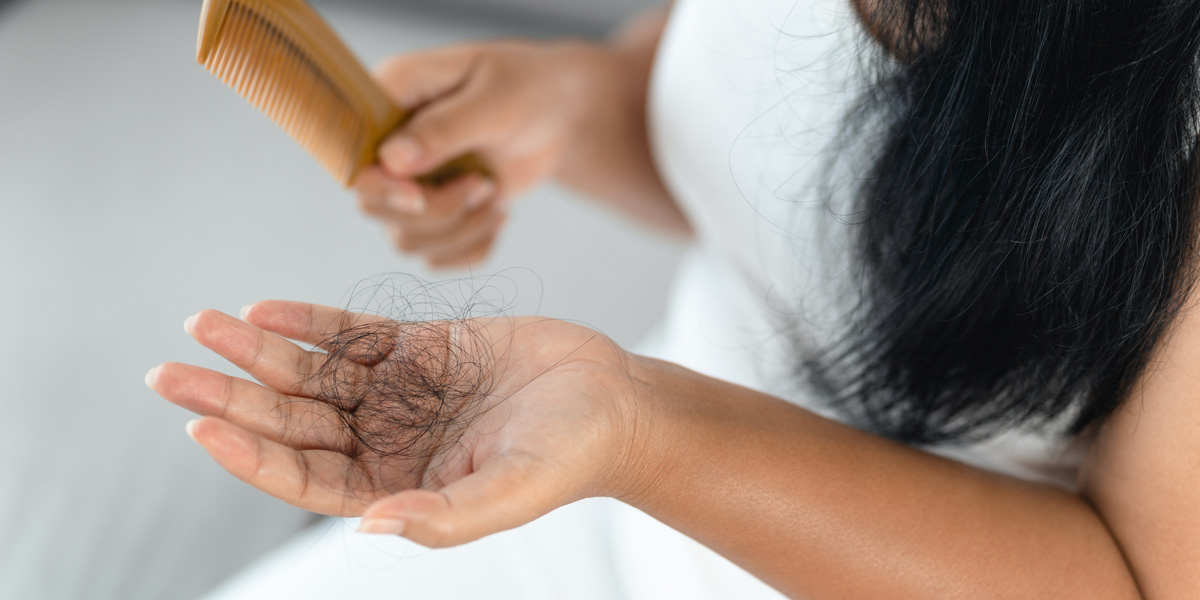
My Hair Is Falling Out – What Do I Do?
September 14, 2022
Firstly, it is important to know that discovering the cause of each patient’s individual hair loss (alopecia), and the personalized approach to treatment, is a journey. Every patient is different, and what may work for you may not work for the next person. It is a mystery that needs to be solved, and you have come to the right place!
WHAT KIND OF HAIR LOSS DO I HAVE?
Non Scarring Hair Loss – Good news, it is reversible! In this category of hair loss, little to no inflammation or irritation is present around the hair follicle. Hair loss may be all over the scalp, or in patches, and may happen gradually or suddenly. Non-Scarring types of hair loss include the following:
Androgenetic Alopecia is a genetic pattern of hair loss, and is the most common form of hair loss. Male pattern thinning is seen most commonly on the crown or the frontal hairline, whereas female pattern thinning occurs across the whole scalp. It it caused by genetics and the over production of male sex hormones called androgens.
Telogen Effluvium is a stress based hair loss, and can be caused by vitamin deficiencies, thyroid disorders, childbirth, viral infections or starting/stopping medications. Hair suddenly sheds for a period of 3-6 months, stops for 3 months, then reverts back to normal hair growth.
Alopecia Areata is an autoimmune disorder where your immune system mistakes the hair follicles as foreign, and attacks them. It presents as sudden, circular bald patches on the scalp.
Scarring Hair Loss – Irreversible
In scarring hair loss, inflammation is present which destroys the hair follicle, leading to scarring and permanent hair loss. Treatment is focused on slowing the progression, and early treatment produces best results. Forms of scarring hair loss include Lichen Planopilaris, Central Centrifugal Cicatricial Alopecia and Frontal Fibrosing Alopecia. Biopsy is required to definitively diagnose these forms of hair loss.
WHAT ARE MY TREATMENT OPTIONS?
Topical Treatments
Topical Minoxidil works by increasing blood flow, which increases oxygen and growth factor delivery to the hair follicle. As we age, the hair follicle shrinks and starts producing a thinner, wispy hair compared to our thick strands of youth. Topical Minoxidil reverses this process by enlarging hair follicles and elongating the growth phase (anagen phase) of the hair, preventing fall out. It is applied 1-2 times daily to the areas of the scalp experiencing hair loss.
Oral Treatments Oral Minoxidil is an antihypertensive vasodilator that works in the same way as topical Minoxidil when taken in low doses, without the hassle of applying a medication to the scalp everyday. Side effects include increased hair growth in other areas, lower extremity edema, raise in blood pressure, and headache.
Finasteride (Propecia) is a 5-alpha reductase inhibitor which blocks the conversion of testosterone to dihydrotestosterone (DHT), the androgen responsible for hair loss. Due to its effects of increasing testosterone, this treatment is used mostly for men. Side effects include sexual dysfunction, so a discussion with your dermatologist to weight the pros and cons is important!
Spironolactone is a potassium-sparing diuretic, originally prescribed for high blood pressure. This medication works by slowing the production of male sex hormones, like testosterone. It is only used to treat hormonal causes of hair loss in women, like androgenetic alopecia.
In Office Treatments
Intralesional Kenalog Injections work by reducing inflammation around the hair follicle to stimulate hair growth. This treatment works well with Alopecia Areata, and forms of scarring alopecia. Injections are administered over a course of months.
Platelet-Rich Plasma Injections are a procedure where your own blood is drawn in the office, spun down in a centrifuge, and injected back into the scalp. Platelet rich plasma consists of two parts – plasma, the liquid portion of blood, and platelets, which play an important role in healing. Platelets contain growth factors which stimulate tissue regeneration, preventing hair loss and regenerating hair growth. Injections are done monthly over the course of 3 months, with best results seen with follow up treatments twice yearly.
WHERE DO I GO FROM HERE?
Schedule a visit with your dermatologist!
Each hair loss appointment begins with a detailed conversation about past and current medical history, medications, emotional stressors, and family history. We then delve deeper by running bloodwork, to determine internal causes, such as thyroid disease, autoimmune disorders, or vitamin deficiencies. Lastly, we perform scalp biopsies, where pathologists determine the cellular structure of your scalp and hair follicles. Once we have the answers, we can come up with a personalized course of treatment.
Written by: Nicole Guerin, PA-C




